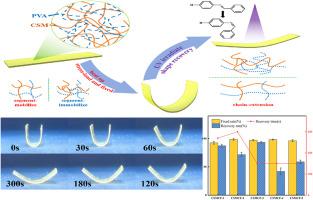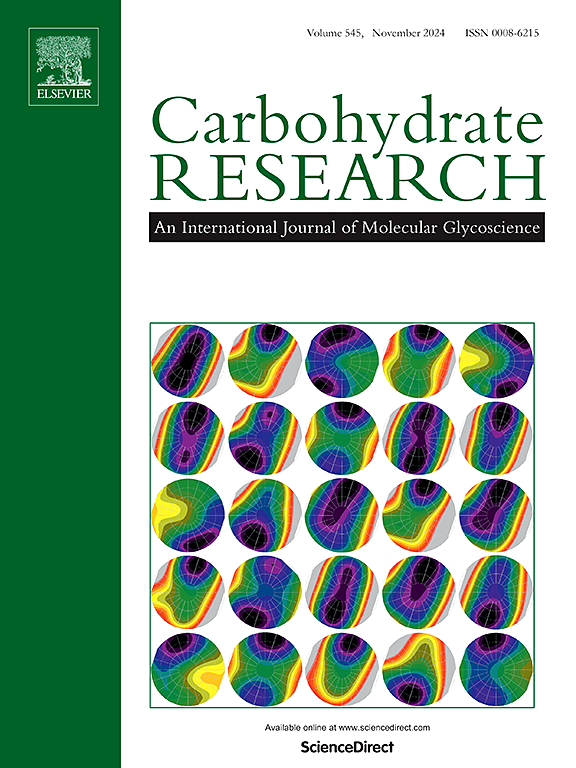Azobenzene-modified chitosan composites harnessing high-efficiency photosensitive shape memory behaviors
IF 2.5
3区 化学
Q3 BIOCHEMISTRY & MOLECULAR BIOLOGY
引用次数: 0
Abstract
Chitosan-based shape memory polymers (SMPs) represent a promising class of smart materials for biomedical and packaging applications, yet their development is often limited by the reliance on solutions and thermal stimuli. To enable remote and precise control, this study focuses on developing photosensitive SMPs by conferring light responsiveness to chitosan. Azobenzene-modified chitosan (CSM) was synthesized via a three-step process involving maleic anhydride modification of chitosan followed by free radical grafting with 4-acryloyloxyazobenzene. Composite films (CSMCFs) were then prepared by blending the CSM with poly(vinyl alcohol) (PVA) at varying mass ratios. The chemical structures of the intermediates and the final composite were confirmed by 1H NMR and FTIR spectroscopy. The incorporation of azobenzene groups was verified by UV–vis spectroscopy, and the thermal properties were assessed by thermogravimetric analysis (TGA) and differential scanning calorimetry (DSC). The photosensitive shape memory behavior was quantitatively evaluated by measuring the shape fixation rate (Rf) and shape recovery rate (Rr) under 365 nm UV light irradiation. The optimal composites (CSMCF-3), with a CSM/PVA ratio of 3/7 and 0.5 % azobenzene derivative, exhibited a high shape fixation rate of 97.2 % and an exceptional shape recovery rate of 93.3 % within 300 s. These results demonstrate the high potential of these composite films for applications in smart packaging and biomedical devices where remote, light-triggered actuation is desired.

利用高效光敏形状记忆行为的偶氮苯改性壳聚糖复合材料。
壳聚糖基形状记忆聚合物(SMPs)代表了一类有前途的智能材料,用于生物医学和包装应用,但它们的发展往往受到依赖解决方案和热刺激的限制。为了实现远程和精确控制,本研究着重于通过赋予壳聚糖光响应性来开发光敏SMPs。采用顺丁二酸酐对壳聚糖进行改性,然后与4-丙烯氧基偶氮苯进行自由基接枝,三步法合成了偶氮苯改性壳聚糖。然后将CSM与聚乙烯醇(PVA)按不同的质量比共混制备复合膜(CSMCFs)。通过1H NMR和FTIR对中间体和最终合成物的化学结构进行了表征。通过紫外可见光谱验证了偶氮苯基的掺入,并通过热重分析(TGA)和差示扫描量热法(DSC)评估了热性能。通过测量365 nm紫外光照射下的形状固定率(Rf)和形状恢复率(Rr),定量评价光敏形状记忆行为。最佳复合材料(CSMCF-3) CSM/PVA比为3/7,偶氮苯衍生物含量为0.5%,在300 s内具有97.2%的形状固定率和93.3%的形状恢复率。这些结果证明了这些复合薄膜在智能包装和生物医学设备中应用的巨大潜力,这些设备需要远程、光触发驱动。
本文章由计算机程序翻译,如有差异,请以英文原文为准。
求助全文
约1分钟内获得全文
求助全文
来源期刊

Carbohydrate Research
化学-生化与分子生物学
CiteScore
5.00
自引率
3.20%
发文量
183
审稿时长
3.6 weeks
期刊介绍:
Carbohydrate Research publishes reports of original research in the following areas of carbohydrate science: action of enzymes, analytical chemistry, biochemistry (biosynthesis, degradation, structural and functional biochemistry, conformation, molecular recognition, enzyme mechanisms, carbohydrate-processing enzymes, including glycosidases and glycosyltransferases), chemical synthesis, isolation of natural products, physicochemical studies, reactions and their mechanisms, the study of structures and stereochemistry, and technological aspects.
Papers on polysaccharides should have a "molecular" component; that is a paper on new or modified polysaccharides should include structural information and characterization in addition to the usual studies of rheological properties and the like. A paper on a new, naturally occurring polysaccharide should include structural information, defining monosaccharide components and linkage sequence.
Papers devoted wholly or partly to X-ray crystallographic studies, or to computational aspects (molecular mechanics or molecular orbital calculations, simulations via molecular dynamics), will be considered if they meet certain criteria. For computational papers the requirements are that the methods used be specified in sufficient detail to permit replication of the results, and that the conclusions be shown to have relevance to experimental observations - the authors'' own data or data from the literature. Specific directions for the presentation of X-ray data are given below under Results and "discussion".
 求助内容:
求助内容: 应助结果提醒方式:
应助结果提醒方式:


